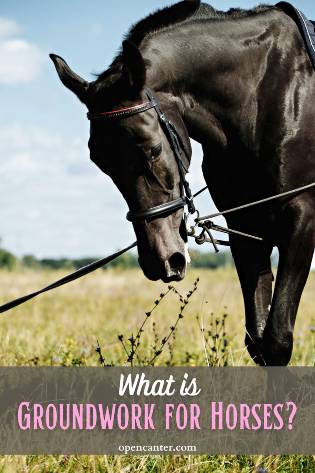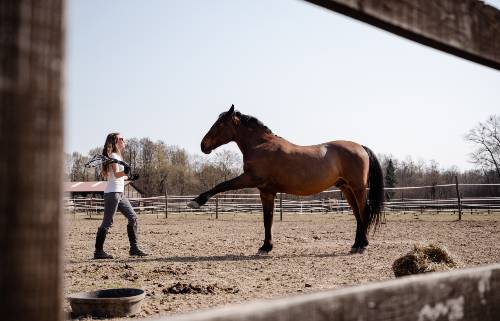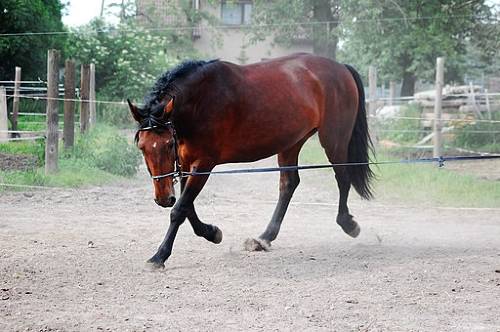Affiliate Disclaimer
As an Amazon Associate I earn from qualifying purchases. It helps me keep the website going. Thank you for your support.
If you are new to riding, you may have heard your instructor talking about groundwork. But what is groundwork for horses and why is it useful?
Not all schooling of horses is done in the saddle. ‘Groundwork’ is used to term structured exercises and cues that are performed on the ground with a horse without mounting up. It can be started with young horses, all the way up to horses that are retired from saddle work.
Groundwork strengthens the relationship between horse and human and helps to establish a better understanding of authority and boundaries.
Through positive reinforcement, it teaches a horse some of the most basic skills such as listening and respect, which can later be translated into more complex requests in the arena.

Why is Groundwork for Horses Important?
Groundwork helps to build good communication and strengthen the connection between horse and owner. Owners can learn how to show effective leadership and guidance using eye contact, body language, and vocal cues.
Horses can learn how to respect these boundaries and understand what is being asked of them such as being led, being loaded into a trailer, and being ready for a farrier appointment.
Groundwork is a fundamental part of training for some of the most elite riding schools in the world. An example of this is the Spanish Riding School in Vienna. Students must undergo 4 years of training on the ground before they can progress to training to ride the infamous Lipizzaner stallions.
It’s also a key part of natural horsemanship for those who seek to build a stronger bond with their horse.
Some horses cannot and will not ever be ridden, whether due to injury, temperament, or age. In these cases, groundwork is the only form of training that can be implemented to get them out of the fields and keep their brains active.
Safety
When working with a 1,000lb animal with a mind of its own, the safety of horse and rider is always a priority. A horse that does not respect its handler can prove incredibly dangerous.
Therefore, introducing key principles on the floor in a controlled environment is a fundamental part of ensuring the safety of both rider and horse.
Additionally, groundwork helps to improve a horse’s confidence around things it might find frightening, like loud noises, plastic bags, or animals. This can help to curb any natural physical response which might endanger the person riding or handling the horse.
Respect and Communication
The key to a successful relationship is effective communication and listening. Groundwork teaches these basic principles of listening and learning, whilst helping to build and strengthen the bond between horse and owner.
If trust is a bank, carrying out regular successful lessons in groundwork is like depositing funds into that bank. Over time these deposits will accumulate into a strong and solid foundation of understanding and mutual respect.

Manners
A well-trained top-tier horse who is winning medals in dressage or show jumping may still be a menace on the ground.
Regular groundwork helps to teach a horse about authority and dominance out of the saddle, making everyday handling on the floor easier and safer for everyone around.
Exercise
Some horses are unsuited to progressing to ridden work, due to injury, age, or temperament. And there are many occasions when horses are “shown in hand”, which means they may be presented at competitions without being ridden.
For these horses, groundwork will be the sole focus of their training. It is a physical form of exercise, which can help increase fitness levels and muscular development. In addition to this groundwork for horses provides mental stimulation, prevents boredom, and engages thinking.
The Best Groundwork Exercises for Horses:
Stand still:
Teaching a horse to stand still, whether when leading, lunging, or at a mounting block, is one of the most vital cues you can develop. It will ensure you have a horse who is not about to tear off whilst you attempt to open a gate or get a foot in the stirrups.
Back up:
Backing up a horse on the ground or in the saddle is also an essential skill ensuring that the horse respects your personal space. It is a basic tool to create respect and can be used practically in backing out of trailers or stables.
When executed correctly, it can also help to teach the horse to engage its hind legs and back up when ridden.
Lead:
All too often, you might see someone careering back from the fields with a horse who is leading them, rather than the other way around. Groundwork in leading helps to teach the horse not to invade your personal space nor try to use its strength to its advantage.

An unruly Shetland pony might prove entertaining to drag along. However, proper handling on the ground is essential for someone leading a large, high-spirited thoroughbred.
Flex and soften to pressure:
Some horses tend to fight pressure, whether it be pulling back on the lead rope or bit. Teaching them when to soften and release, and when to flex, is a key tool that can be implemented through groundwork.
Consistency and Repetition
It is only through regular repetition that a new habit can become established in the mind of horses and humans. This proves true for both positive and negative habits; a horse who is always allowed to walk off whilst being mounted will continue doing so.
Bad habits are often harder to unlearn than to get right the first time around. The key to successful outcomes in groundwork for horses is setting expectations and rules and sticking to them.
Shorter sessions of 10 – 15 minutes are often more beneficial when it comes to groundwork for horses. The ‘reward’ of successfully accomplishing and learning a lesson is completion. And this means your horse gets to go back out to the field to see his friends, or back to his stable and dinner.
It’s better to end a shorter session on a good note when your horse is listening and performing well to your instructions. The groundwork practices are most effective when applied consistently little and often.
Final Thoughts
Groundwork can improve your relationship with your horse, and lead to safe behavior both on the ground and in the saddle. It’s also a great way to form a deeper bond with your horse outside of riding.
Use a brief but focused regular groundwork session, such as a pre-ride warmup for your horse. This can help to develop a well-behaved horse who is easy to work with.




